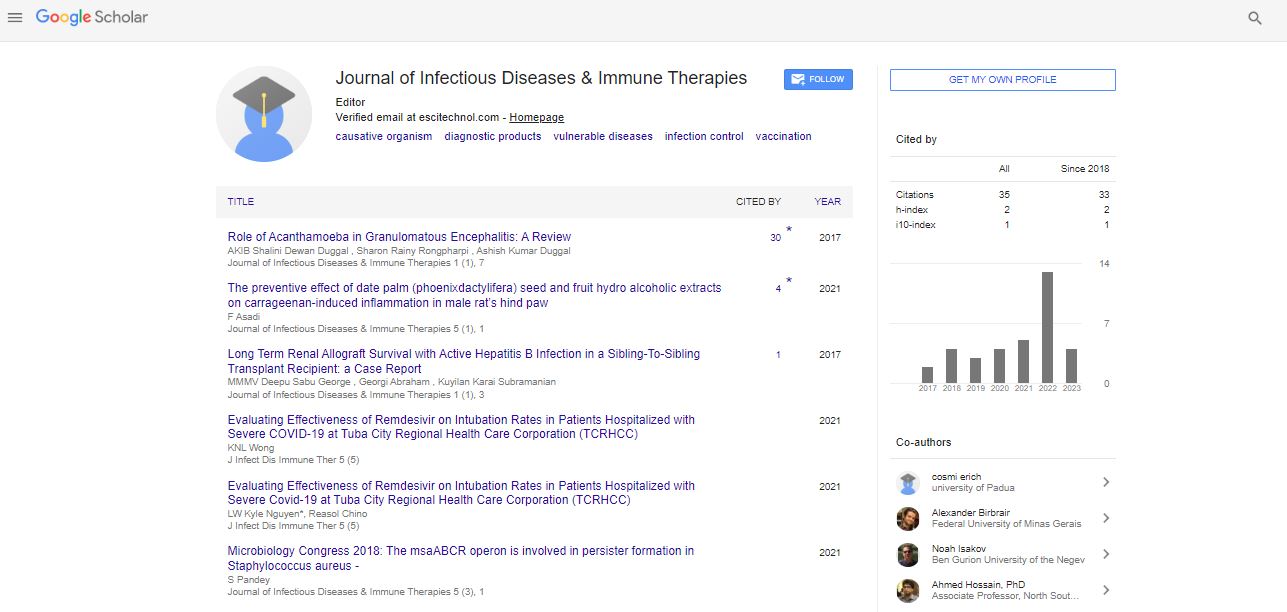Commentary, Vol: 12 Issue: 2
Bloodstream Infections: Origins, Manifestations, Diagnosis, and Management
Jana Sherlock*
Department of Genetics, Stanford University School of Medicine, Stanford, USA
*Corresponding Author: Jana Sherlock
Department of Genetics, Stanford
University School of Medicine, Stanford, CA, USA
E-mail: gshejana@stanford.edu
Received date: 27 May, 2023, Manuscript No. JIDITH-23-106351;
Editor assigned date: 29 May, 2023, Pre QC No. JIDITH-23-106351 (PQ);
Reviewed date: 15 June, 2023, QC No. JIDITH-23-106351;
Revised date: 23 June, 2023, Manuscript No. JIDITH-23-106351(R);
Published date: 30 June, 2023, DOI: 10.4172/2329-9541.1000340
Citation: Sherlock J (2023) Bloodstream Infections: Origins, Manifestations, Diagnosis, and Management. J Immunol Tech Infect Dis 12:2.
Description
Blood infections, also known as bacteremia or sepsis, are severe medical conditions characterized by the presence of bacteria or other infectious agents in the bloodstream. This aims to provide a comprehensive overview of blood infections, including their causes, symptoms, diagnosis, and treatment options. Understanding the complexities of blood infections is essential for healthcare professionals in order to facilitate prompt and effective interventions, thereby improving patient outcomes.
Blood infections, also referred to as bacteremia or sepsis, are lifethreatening conditions that occur when infectious agents enter the bloodstream. These infections can arise from various sources, including primary infections or the spread of bacteria from other sites within the body. This aims to elucidate the causes, symptoms, diagnosis, and treatment options for blood infections, with the goal of enhancing clinical understanding and patient care.
Blood infections can be caused by a wide range of infectious agents, including bacteria, viruses, fungi, and parasites. Bacterial infections are the most common cause of blood infections, with gram-positive bacteria such as Staphylococcus aureus and Streptococcus species being frequent culprits. Viral blood infections, although less common, can result from viruses like HIV, hepatitis B, and hepatitis C. Fungal blood infections, often seen in immunocompromised individuals, can be caused by Candida species or Aspergillus. Parasitic blood infections, such as malaria, are prevalent in certain geographical regions. The introduction of pathogens into the bloodstream can occur through wounds, surgical procedures, catheters, or the spread of infection from other sites within the body.
Recognizing the symptoms of blood infections is vital for early detection and appropriate management. The clinical presentation of blood infections can vary widely, but common symptoms include fever, chills, rapid heartbeat, low blood pressure, and altered mental status. Patients may experience localized signs of infection, such as redness, warmth, or swelling at the site of infection. In severe cases, blood infections can progress to septic shock, characterized by organ dysfunction and a significant drop in blood pressure. Prompt recognition of these symptoms is difficult, as delayed treatment can lead to poor outcomes, including organ failure and death.
The diagnosis of blood infections requires a systematic approach involving clinical evaluation and laboratory investigations. Physicians may suspect blood infections based on the presence of characteristic symptoms and signs. Laboratory tests play a central role in confirming the diagnosis and identifying the causative agent. Blood cultures, which involve culturing a sample of blood in a suitable medium, are the gold standard for diagnosing blood infections. Additional tests, such as complete blood count, inflammatory markers, and imaging studies, may aid in evaluating the severity of the infection and identifying the source of the infection.
The management of blood infections necessitates a multidisciplinary approach, involving antimicrobial therapy, supportive care, and source control. Empirical antibiotic therapy is initiated promptly while awaiting the results of blood cultures. Once the causative organism is identified and its susceptibility pattern determined, targeted antimicrobial therapy is initiated. In severe cases of sepsis or septic shock, patients may require intensive care management, including hemodynamic support, mechanical ventilation, and fluid resuscitation. Source control, such as drainage of abscesses or removal of infected devices, is essential to eliminate the primary focus of infection.
Blood infections are serious medical conditions that require timely recognition and appropriate management. Early diagnosis, prompt initiation of antimicrobial therapy, and source control are vital for improving patient outcomes. Healthcare professionals must remain vigilant and aware of the diverse causes and symptoms of blood infections to ensure timely intervention. Ongoing research efforts aimed at developing novel diagnostic methods and effective treatments are essential for further advancements in the field.
The blood infections are life-threatening conditions that require a comprehensive understanding by healthcare professionals. Timely diagnosis, appropriate antimicrobial therapy, and supportive care are essential for improving patient outcomes. By enhancing awareness and knowledge of blood infections, healthcare providers can play an essential role in reducing morbidity and mortality associated with these severe infections.
 Spanish
Spanish  Chinese
Chinese  Russian
Russian  German
German  French
French  Japanese
Japanese  Portuguese
Portuguese  Hindi
Hindi 